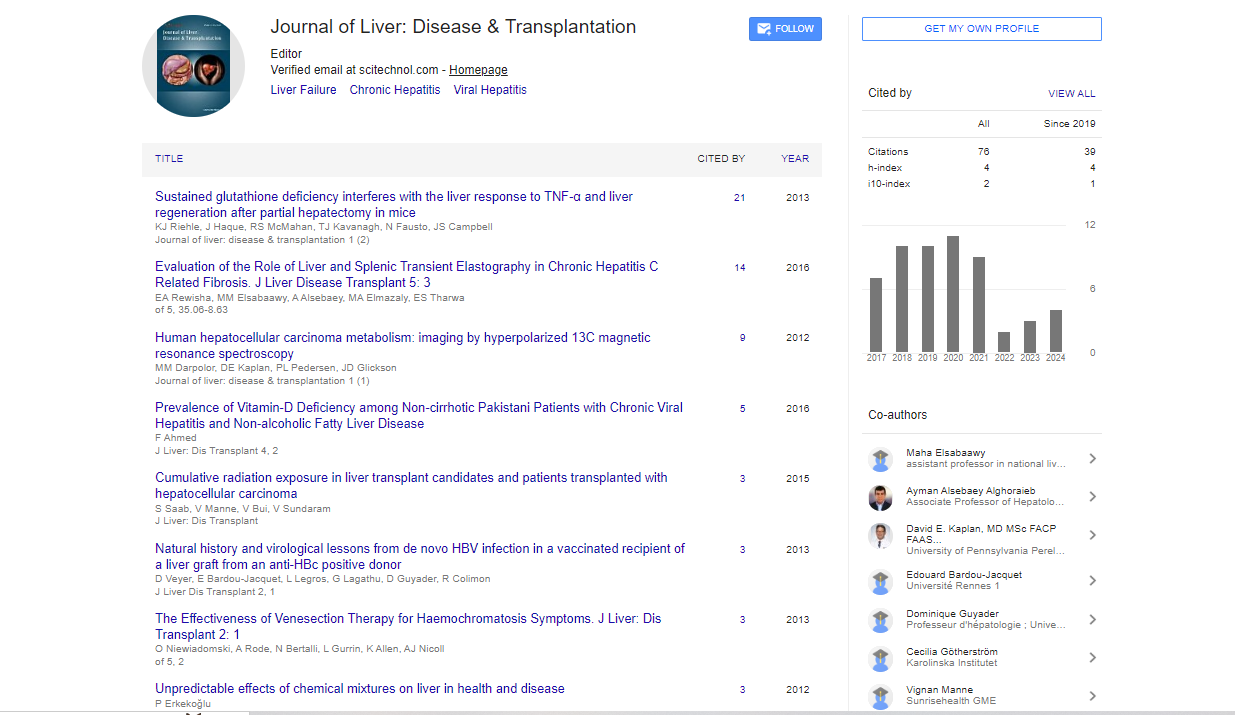Opinion Article, J Liver Disease Transplant Vol: 13 Issue: 3
Emerging Therapies for Autoimmune Liver Diseases: Primary Biliary Cholangitis and Primary Sclerosing Cholangitis
Sophia Martinez*
1Hepatology Department, Karolinska Institute, Stockholm, Sweden
*Corresponding Author: Sophia Martinez,
Hepatology Department, Karolinska Institute, Stockholm, Sweden
E-mail: sophia.martinez@ki.se
Received date: 26 August, 2024, Manuscript No. JLDT-24-151921;
Editor assigned date: 28 August, 2024, PreQC No. JLDT-24-151921 (PQ);
Reviewed date: 11 September, 2024, QC No. JLDT-24-151921;
Revised date: 18 September, 2024, Manuscript No. JLDT-24-151921 (R);
Published date: 25 September, 2024, DOI: 10.4172/2325-9612.1000272
Citation: Martinez S (2024) Emerging Therapies for Autoimmune Liver Diseases: Primary Biliary Cholangitis and Primary Sclerosing Cholangitis. J Liver Disease Transplant 13:3.
Description
Autoimmune Liver Diseases (AILDs) includes a range of conditions where the body’s immune system erroneously targets the liver, leading to inflammation and damage. Among these, Primary Biliary Cholangitis (PBC) and Primary Sclerosing Cholangitis (PSC) are the most prevalent. Both are chronic, progressive diseases that predominantly affect the bile ducts, leading to fibrosis, cirrhosis and eventual liver failure if left untreated. Despite significant advancements in understanding these conditions, effective therapies have remained limited. However, recent developments in immunology, molecular biology and pharmacology are important treatments that could change the management and prognosis of PBC and PSC.
Primary Biliary Cholangitis (PBC)
Primary Biliary Cholangitis is a chronic, autoimmune disease characterized by the gradual destruction of the small bile ducts within the liver. It affects middle aged women and is associated with the presence of Anti-Mitochondrial Antibodies (AMA). The pathogenesis of PBC involves a complicated interaction of genetic susceptibility, environmental triggers and dysregulated immune responses, which together lead to the destruction of biliary epithelial cells. The standard treatment for PBC has long been Ursodeoxycholic Acid (UDCA), a bile acid that helps to improve bile flow and reduce liver injury. UDCA has been shown to improve liver biochemistry and delay disease progression, but it does not halt disease progression in all patients. For those who do not respond to UDCA, Obeticholic Acid (OCA), a Farnesoid X Receptor (FXR) agonist, has emerged as an alternative. OCA has been shown to reduce liver inflammation and improve cholestasis in patients with inadequate response to UDCA, yet its side effects, including pruritus and elevated cholesterol, limit its usage for longer duration.
Autotaxin is an enzyme involved in the production of Lysophosphatidic Acid (LPA), which plays a role in liver fibrosis and inflammation. Inhibiting autotaxin can reduce fibrosis and cholestasis, making it an attractive target for PBC. Clinical trials with autotaxin inhibitors have shown promising results, with reductions in fibrosis markers and improved liver function. However, further studies are needed to assess long-term efficacy and safety. A growing understanding of the immune system’s role in PBC pathogenesis has led to the development of therapies aimed at modulating the immune response. One such therapy is fostamatinib, a Spleen Tyrosine Kinase (SYK) inhibitor that targets B-cells and reduces inflammation. Earlyphase trials have demonstrated the potential of fostamatinib in decreasing disease markers and improving liver function in PBC patients.
Primary Sclerosing Cholangitis (PSC)
Primary Sclerosing Cholangitis is a chronic disease characterized by inflammation and fibrosis of the bile ducts, which leads to progressive liver damage and cirrhosis. Unlike PBC, PSC is strongly associated with Inflammatory Bowel Disease (IBD), particularly ulcerative colitis. The etiology of PSC is thought to involve a combination of genetic factors, immune dysregulation and microbial influences. The disease can lead to complications such as bile duct strictures, cholangiocarcinoma and liver failure. There is currently no Food and Drug Administration (FDA) approved drug for the treatment of PSC and management is primarily supportive. The use of UDCA in PSC has been controversial, as while it is effective in improving liver biochemistry, it does not alter the course of the disease or prevent progression to cirrhosis. The risk of cholangiocarcinoma remains high in PSC patients, further complicating treatment strategies. For patients with significant fibrosis or cirrhosis, liver transplantation remains the only definitive treatment.
In PBC, FXR agonists like OCA are being tested for PSC. FXR regulates bile acid synthesis and metabolism and activating this receptor has been shown to reduce inflammation and fibrosis in preclinical models. Early phase clinical trials have shown that FXR agonists may reduce cholestasis and improve liver function in PSC patients. However, long-term data on the effects of FXR activation in PSC is still lacking. JAK inhibitors, such as Tofacitinib, are being explored for their potential to modulate the immune response in PSC. Given the association between PSC and IBD, JAK inhibitors may provide therapeutic benefit by targeting the underlying inflammation. In preliminary studies, tofacitinib has shown promise in reducing hepatic inflammation and improving the overall clinical outcomes in PSC patients.
Conclusion
The management of PBC and PSC has undergone essential developments as the novel therapies focused on regulating immune dysregulation and slowing disease progression. While the current treatment landscape primarily involves the use of UDCA, obeticholic acid and supportive therapies, emerging therapies such as autotaxin inhibitors, immune modulation and bile acid receptor agonists provide more targeted and effective treatment options. As study continues to uncover new insights into these diseases, the possibility of more personalized and effective therapies becomes increasingly feasible. However, rigorous clinical testing, long-term follow-up and a deeper understanding of the disease mechanisms are necessary before these emerging therapies can be fully integrated into clinical practice.
 Spanish
Spanish  Chinese
Chinese  Russian
Russian  German
German  French
French  Japanese
Japanese  Portuguese
Portuguese  Hindi
Hindi 